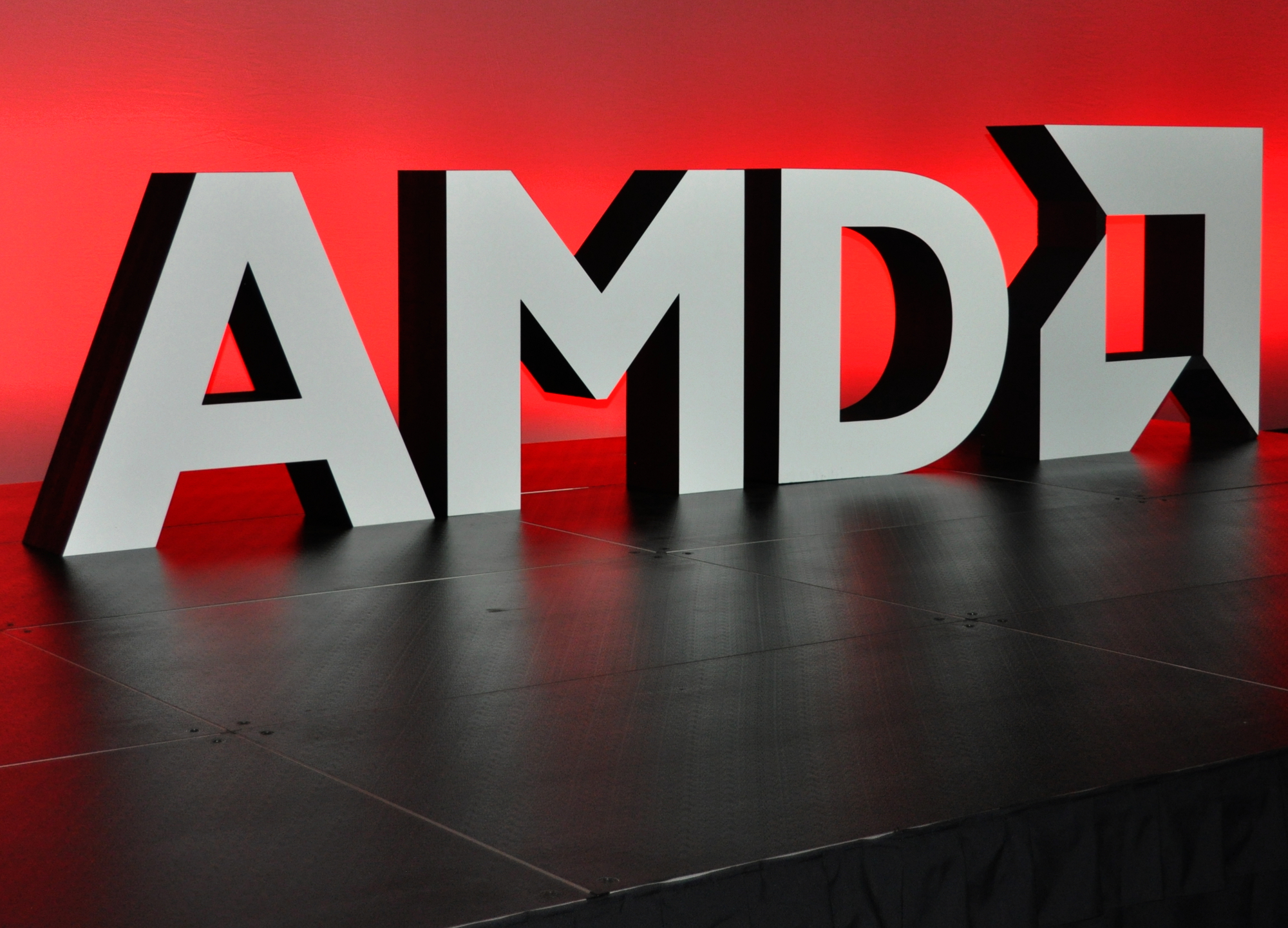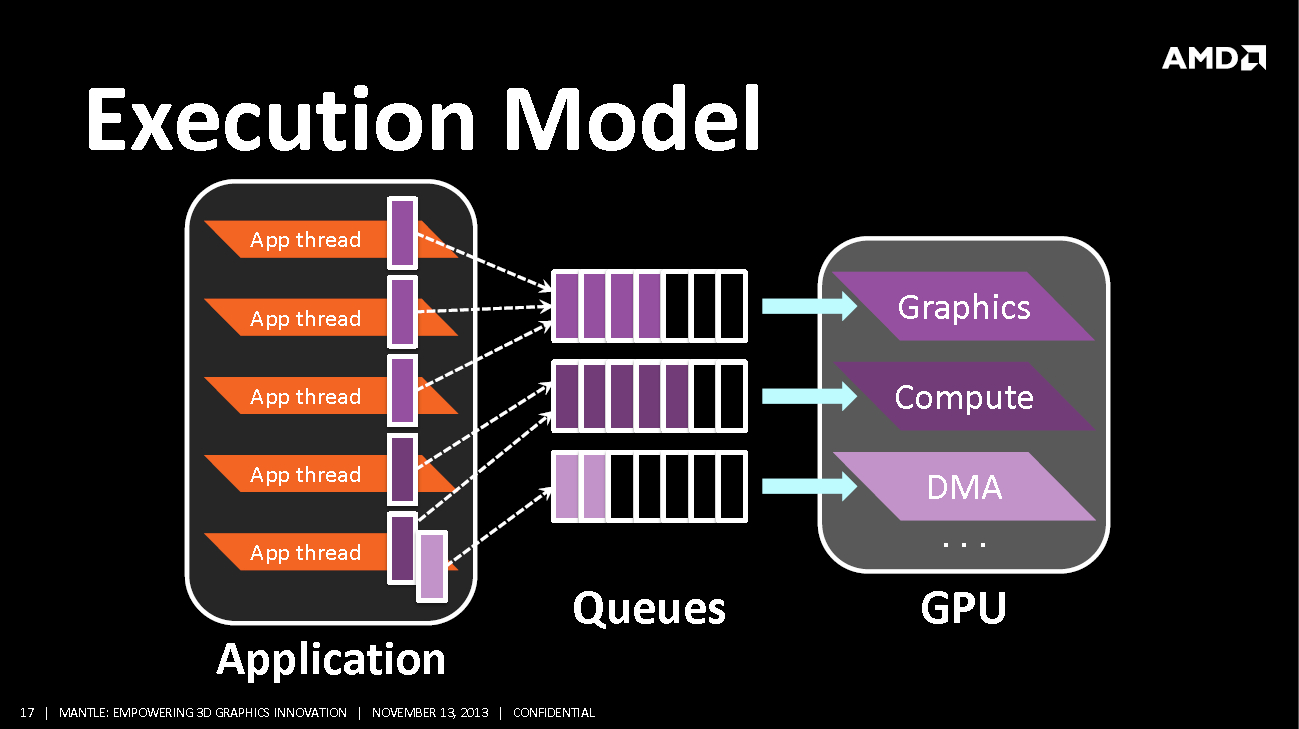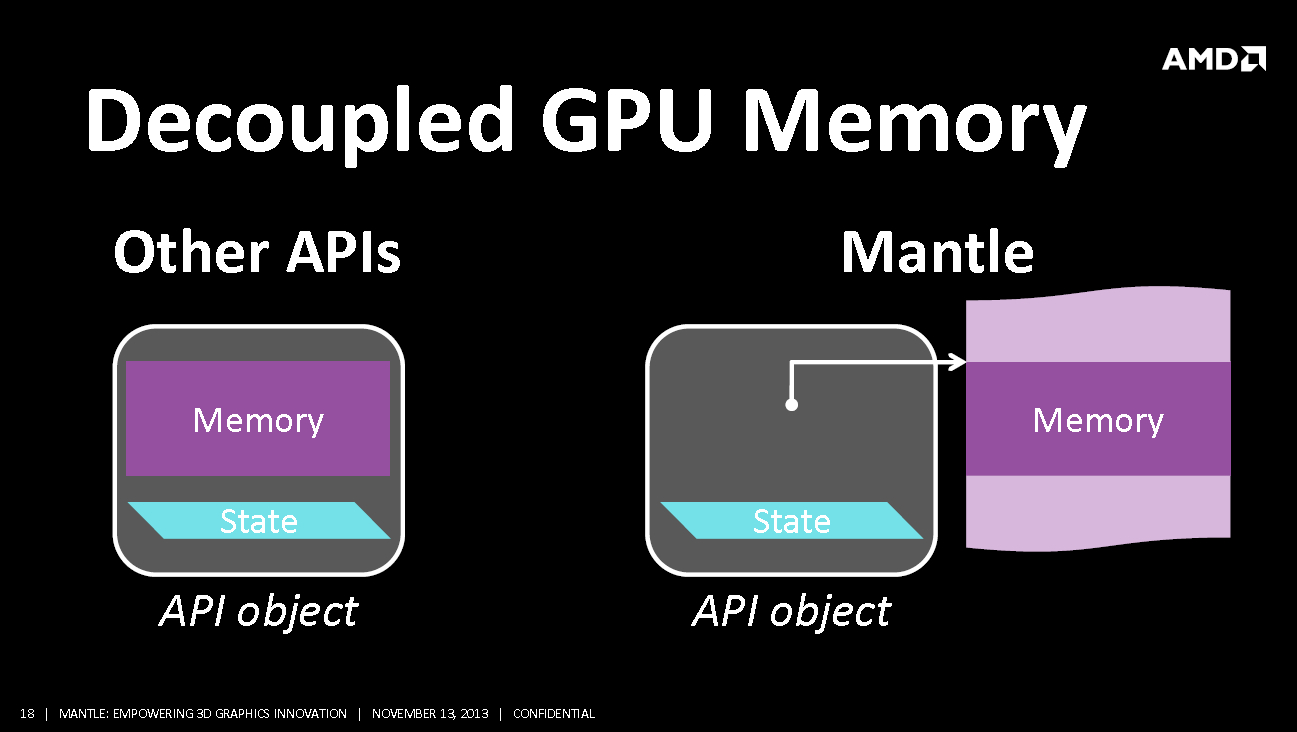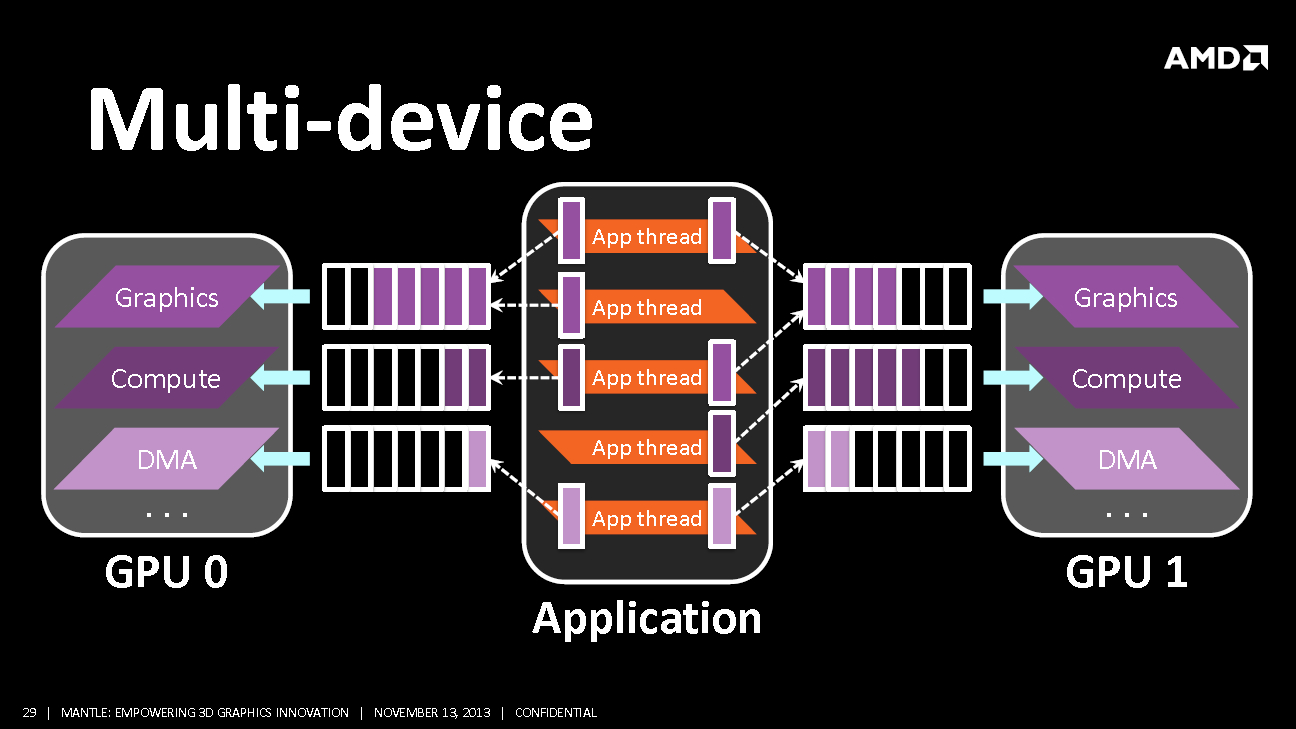AMD APU13: Mantle Shooting for 100,000 Draws per Frame
AMD had several sessions discussing Mantle.
On Mantle
"I think this solution will blow your socks off in terms of CPU utilization." -Guennadi Riguer, AMD
Why Mantle? Why another API? That was the question answered by AMD's Guennadi Riguer during the company's developer summit this week. He said that the existing APIs will only get developers "so far", and that's not what game makers want. They want performance problems solved once and for all, and they want control over the graphics hardware. That's where Mantle comes in.
"What we're trying to do really re-energize the industry because really over the last couple of years, we've been kinda stagnant as an industry," he said. "We would like to kick it up a notch and really give the tools to make exciting PC games."
He said AMD is not trying to please everyone with Mantle: they're not targeting every developer in the industry. However the API is designed to improve GPU efficiency by bringing developers a little closer to the hardware. Mantle is a "low level" API, lower than many other solutions offered to developers, but it's not so low that developers are toying with metal bits.
100,000 Draws Per Frame
"We have a bunch of interesting features that allow you to unlock performance never before possible," he said. "Some of those are generic, others are targeted more at GCN architecture. So there's a wide range of different things to enable very good performance. And while GPU performance is very important, I think this solution will blow your socks off in terms of CPU utilization."
He went on to say that developers typically can usually squeeze out 3 to 5 thousand draws per frame; only a few games manage 10,000 draws per frame at 50 to 60 Hz. With Mantle, AMD is taking an aggressive stance by targeting 100,000 draws per frame at "reasonable" frame rates. With more optimizations, he believes that developers could achieve even higher numbers.
Get Tom's Hardware's best news and in-depth reviews, straight to your inbox.
What does that mean for PC gamers? A more responsive app, new effects and realism, a fuller environment and more. Lower systems, especially those with GCN-based GPUs, will be empowered with new visuals thanks to optimized performance. Other Mantle benefits include more predictable performance and behavior, sharing PC optimizations with the GCN-based Xbox One and PlayStation 4, and the opportunity to apply "novel" techniques.
"The key today to great performance is multi-threading," he said. "All of us have many core systems: four, six, eight core systems. And the problem is very few of those cores are available for driving graphics today. This is just plain wrong. The memory management on PC kinda gets in the way, because if you think about it, on the consoles with a much smaller memory footprint, you are actually able to achieve much greater visuals than you could on PCs with bigger memory configurations. We can fix that."
Mantle Efficiency
Later on he talked more about Mantle empowering low spec systems. That's important to developers and customers because suddenly the user base has expanded. He said it also means that they're much aligned with the current trend to low-power devices, tablet-like devices or any other slim devices. Those are the devices that are in the most need for an efficient way of driving the GPUs and CPUs. He said Mantle is uniquely positioned to deliver the best proposition on those types of low-power systems.
In a separate Mantle session Oxide Games discussed the studio's experience using Mantle, indicating that the API enables high batch counts, meaning any command sent to the GPU, not just draws. The team expects to push 300,000 batches by 2015, and 1 million batches at 60 frames per second by 2018. At this point everything starts to change: CPUs and GPUs will start calling code back and forth on each other. The hard line between the two will go away and all sorts of interesting things will begin to happen. Mantle seems to pave the road for this scenario to take place.
"Mantle is not expensive to support," said Tim Kipp. "It's fairly cheap. And I think the big key for us is that it's a fixed cost. We're basically going to port our driver interface layer once and then it's just going to work and there's not a whole lot of extra maintenance we have to do to support it. And the really big thing we're excited about is to push the industry forward, to try out new techniques and new APIs."
Lower Latency
Thanks to Mantle, apps with lower framerates still feel faster because the latency is better. The team is also able to add features they weren't sure would be possible for performance reasons such as film quality motion blur and other film-style techniques. The studio also provided a demo showing several battleships in space loaded with turrets, and hundreds of fighter ships shooting lasers at fleets of enemy ships. The rendering was in real time: you could zoom out and view the whole battle while keeping an incredibly fluid framerate.
Ultimately one thing was made clear during the presentations: Mantle is not simply just for AMD APUs and GPUs. The technology is reportedly open, so whether Nvidia accepts the tech or not is a different story altogether, but it's there for the GeForce company to embrace.

Kevin Parrish has over a decade of experience as a writer, editor, and product tester. His work focused on computer hardware, networking equipment, smartphones, tablets, gaming consoles, and other internet-connected devices. His work has appeared in Tom's Hardware, Tom's Guide, Maximum PC, Digital Trends, Android Authority, How-To Geek, Lifewire, and others.
-
xiinc37 I want to know how this applies to Nvidia, because its optimized for GCN? With both of them on board, I think this will be awesome.Reply -
Geef I hope this is adopted quickly. Even if it isn't this might be the kick in the pants Microsoft needs with DirectX to make it more useful.Reply -
doron Reply11938504 said:I want to know how this applies to Nvidia, because its optimized for GCN? With both of them on board, I think this will be awesome.
Last paragraph: "Ultimately one thing was made clear during the presentations: Mantle is not simply just for AMD APUs and GPUs. The technology is reportedly open, so whether Nvidia accepts the tech or not is a different story altogether, but it's there for the GeForce company to embrace."
You can't know if you don't read. -
vmem I think AMD is going to leverage the console advantage they gained, and push heavily on PC gaming optimizations to try to capture some market back from Intel.Reply
Meanwhile, Nvidia is seeking a new source of revenue. since they have over 60% of discrete GPU market and more for GPU compute, they won't get too much more profit out of either market regardless of what they do. To do this, Nvidia is apparently pushing mobile lines, and obviously looking forward to Cloud streamed gaming in the future. I think in the short run AMD will win out with Mantle and all the other stuff they're doing. hopefully that gives them enough profits to stay competitive in the long run -
Amdlova Go AMD bring the glide again I still love when show 3DFX on scren or GLIDE when you start the game... Old days never come back. but I see the HopeReply -
tomfreak @xiinc37 click @ 2.00 http://www.youtube.com/watch?v=tDPgJB2x7dQReply
He says pretty clear, mantle is low level enough, but not tooo low to be GCN specific, AMD wanted to still have the ability to change architecture in the future, with that in mind not lowest level API also give their competitor be able to support. Basically he is saying "join now Nvidia, or u gonna get left out in dust" :-D -
xiinc37 Reply
Well duh, that quote is exactly what I was referring to. It says Nvidia can make use of it, but it doesn't say how.11938661 said:Last paragraph: "Ultimately one thing was made clear during the presentations: Mantle is not simply just for AMD APUs and GPUs. The technology is reportedly open, so whether Nvidia accepts the tech or not is a different story altogether, but it's there for the GeForce company to embrace."
You can't know if you don't read.
11938883 said:@xiinc37 click @ 2.00 http://www.youtube.com/watch?v=tDPgJB2x7dQ
He says pretty clear, mantle is low level enough, but not tooo low to be GCN specific, AMD wanted to still have the ability to change architecture in the future, with that in mind not lowest level API also give their competitor be able to support. Basically he is saying "join now Nvidia, or u gonna get left out in dust" :-D
Thanks, I'll check that out. -
beta212 Best I've seen people do with Cryengine is 4k draw calls. This is a 25x improvement, question is, will cryengine implement it? Will game devs have to do any specific coding to support it?Reply -
dudewitbow Reply11939079 said:Best I've seen people do with Cryengine is 4k draw calls. This is a 25x improvement, question is, will cryengine implement it? Will game devs have to do any specific coding to support it?
developers tie in the calls directly into the games engine. EA was pretty much the one who wanted a low level API. Once Frosbites Engine is finished for BF4, it is able to be applied on all other frostite 3 titles(EA reported 15+). IIRC, EA is implementing mantle into Cryengine 4, so its not going to be any time soon where it will be used in games that use CE3 yet.
if anyone is wondering why Nvidia wasn't originally on the ball with this:
Andersson took the concepts for a new low-level API and approached AMD, Intel, and Nvidia with the software, with the goal to have a company evangelise it and eventually turn it into a software standard. Only AMD was eager to adopt it and eventually called it Mantle to tie into their reveal for the Volcanic Islands family of GPUs.
Source
So its implied it wasn't something AMD had originally sought out to do, it was definitely something they jumped on when the idea rose that the other 2 didn't go after at the time. -
DarkMantle Reply11939146 said:So its implied it wasn't something AMD had originally sought out to do, it was definitely something they jumped on when the idea rose that the other 2 didn't go after at the time.
You can read about it on Tom's AMD AMA article
http://www.tomshardware.com/reviews/amd-ama-toms-hardware,3672-4.html
"Q. What was the influence to do something like Mantle when we have seen other projects like "GLIDE" fail? What do you think will make your solution better or more enduring?
A. Game developers requested Mantle themselves. That's the key difference. The industry told us they want it.
Q. A followup: you mentioned that developers requested Mantle. How so? And what is your favorite color?
A. Johan from DICE sat across the table from Matt Skynner, the GM of our graphics business, and explained how he wanted a close-to-metal graphics API. Matt said "we can do that," and the rest was history. Other devs are very excited when they learn about what Mantle is capable of, and how Mantle can help them bring their game to life on the PC."





